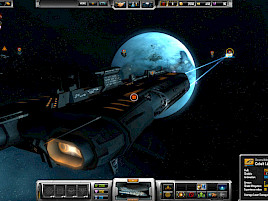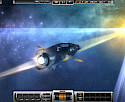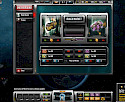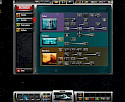Sins of a Solar Empire Review
I admit my hands might have been slightly trembling while I waited for Sins of a Solar Empire (Sins) to download. The promise of a 4X game, played out in real-time (a so-called RT4X game), with huge battles spanning over several star systems is something space strategy players has been waiting for… since I can remember. Much more eagerly so after the not-so-shiny Master of Orion 3…
You may have noticed that this review has taken a lot of time to be written. Do try to see the good side of the delay; after playing countless games one becomes insensitive to hype. Not a guarantee for a good review, but I’m trying to find an excuse for having played this long without writing a word. Also do take into consideration that I am describing version1.04, meaning a patched game.
It is hard to believe that this game is Ironclad Games' first project! That being said, the game is here and Stardock must be happy they chose to publish it. One of the reasons is that Stardock now has a nice selection of late space strategy games available over at Stardock Central. Galactic Civilizations II, Sword of the Stars with Born of Blood expansion and now Sins of a Solar Empire make a hell of a package – and there is more. You are bound to find something to like here.
But I am rushing things. I still haven't told you what you will find in Sins, so read on.
Although history of Sins races was already explained in our preview some refreshing won't hurt.
General
Ten millennia ago something stirred in the depths of space and forced Vasari, an alien species, to flee from their world. They adopted a grasshopper way of life; to run, graze green pastures wherever they go, and run again, fear preventing them from settling down again.
Thousand years ago people shunned a group of mind-powers practicing deviants that just didn’t live up to our norms. They were kicked off the desert world they were hiding on and left to fend on their own. These people called themselves the Advent and they didn’t like their exile.
Ten years ago, after a millennium of peaceful existence in our corner of the universe, Vasari came. They may be on the run but that doesn’t mean they will stop at a puny obstacle like Humans on the way to resources that will fuel their stampede further. We were forced to forge Trader Emergency Coalition (TEC) and fight for our lives. Cargo ships were transformed into makeshift battleships and Humans got a fighting chance.
Until now things were turning for the better. Vasari advance was stopped. People were able to breathe a little easier. But hope didn’t last long. The Advent managed to put their twisted mind powers into practice and build a war machine. Needless to say, revenge is a powerful motivator – they came at the back door when nobody expected them. Now TEC is throwing everything it has into defense on two fronts.
Sins start with enough options to give each game the potential to run very different. Players can change the speed of next to everything; income, build, research, speed of ships and speed of culture spread. Besides that you can choose from one of the three races I wrote about. Humans, Vasari and Advent makes for a lot of eye candy; each with its own very different ship and building style, not to mention the weapons effects. Players can also change difficulty level, AI playing style (offensive, defensive etc.) and presence/absence of pirates.
The strategy map consists of one to several star systems, each containing several to a lot of planets. Does that seem like a vague description? Perhaps, but it gets even vaguer. In Sins we can’t even talk about the strategy map in usual terms. Unlike most other games where battlefields are created for the duration of a battle, the whole space in Sins exists full time. Real time makes the usual distinction between strategic and tactical part blurred, but that is the whole point.
Nevertheless I will use the term tactics for everything that happens in a single gravity well – a sphere of high gravity around a heavenly body – and strategy for anything on a larger scale for the purposes of this review. This also means that strategy map is the view you get if you zoom out of action enough to see the links between gravity wells and loose sight of every detail in an individual gravity well.
Ships travel from one gravity well to another via phase lanes, meaning lanes along which faster-than-light travel is possible.
Well (not the gravity well, just… well), zoomed out enough you will see phase lanes connecting gravity wells, drawing a nice web in the solar system. Zooming even further out you will be able to see all solar systems in the current game. Each – for your viewing pleasure – looking somewhat like a galaxy. Planets and the star are junctions in the phase-line web each system forms. Yet they are not the only junctions you will see. There are rich asteroid fields, dead asteroids, black holes and plasma storms as well. Stars are connected with long-range phase lanes, too long for a “normal” technology to bridge the gap. So what you can do is research an advanced technology, become able of interstellar travel and contest for other solar systems.
Asteroids and planets can have civil and tactical orbital structures built around them. Both types of structures have their limits so one is advised not to build only laboratories around a planet – later civilian infrastructure that becomes available through research is very useful as well. Trade ports and refineries add life to your empire (not to mention the flow of money and resources) with a crowd of civilian ships flying around.
As written in the preview, the scope of the game is huge, especially considering the real-time nature. Ship sizes vary from tiny fighters to frigates, cruisers and huge capital ships. When you encounter a planet it makes a capital ship look like a bee but stars… Stars dwarf them all. Taking some time to watch a battle in a star’s gravity well is a must do. It gives a glimpse of an answer to your wondering about the endlessness of space.
Strategy
There were some changes made to the strategic part of the game since the preview. Resource management remained the same though. The game has three resources; crystals, metal and money. The first two can be mined and refined while money is made by population of planets/asteroids and by trade. A “black market” lets you trade crystals and metal for money and vice-versa. You can also place bounties on other players. The bigger the bounty the more its target is attacked by pirates, who act more or less like mercenaries.
The diplomacy part has changed as well. A “love-o-meter” has been installed. It basically tells you what other factions in the game think of you. Needless to say, the more they like you the easier it is to forge an alliance with them. They also don’t refrain from telling you what exactly they want. This can vary from wanting one or the other resource or simply that you destroy their enemy’s structures. The new system does add some new strategic content but I was really bothered by the fact I can only follow the demands of others while not being able to demand anything on my own. Seriously, I know you want something and that this will make you like me more. Why don’t you want to know what I want so that I will like YOU more?!
Research remains divided into military and civilian and there are two different research facilities. The level of military research you can achieve is limited by the number of military research facilities, same goes for civilian research. What have been completely reworked are the fleet supply system and how many capital ships your empire can sustain. These two now have separate research topics and if both are researched your fleets can grow larger and can contain more capital ships.
After playing all races a couple of times you do notice that all three have the same research tree with rare exceptions. True, research topics are named differently for each race, yet they have more or less the same effects and offer no different gameplay for the races.
The fleet supply I wrote about is fleet supply only in name. Once your ships are built they are no burden to your empire. Ships need maintenance? Free of charge. Ships can be upgraded because your research led to new discoveries? Free of charge, automatic and instant across the universe. I agree that the term 4X does not include the word “realism” or “strategy” but it has always been very closely related to them in gamers’ minds. Sins cuts too many corners to be a true 4X game, turns or no turns.
What the game also lacks is a campaign. I’m not a huge campaign fan myself and my appetite was mostly sated by a large variety of maps to play in sandbox. Changing the options can also lead to very different games. That being said, the story Sins tells in the intro movie calls for attention.
I want to lead Vasari, running and gunning, having less but better. I want to be a trader, attacked by this Vasari menace. Forming Trader Emergency Coalition and fighting with quantity to save my life just to find they are not the only enemy. And I want revenge, using my mind powers and cunning to subdue the ones who exiled my forefathers, just because they were different. Better. Advent.
This leads me to another issue. The three factions are – story wise – very different. One is a very advanced alien race that started running ten millennia ago, meaning that even then they had the means to escape from something very dreadful. Would they not be very advanced in comparison to other factions? Would they, being on the run, not refrain from forming colonies or building powerful planetary defenses and rather focus on offense heavily? But playing the game as Vasari is exactly the same as TEC or Advent. Teleportation, the only real Vasari difference in the game, is one of their high tier research options which in smaller games you won’t even research. They bring nothing special to the table.
The Advent has an advantage of a millennium of revengeful and warlike research over the peaceful TEC. Yet they have come up with nothing really superior to their TEC adversaries who only had a decade to transform trade ships into makeshift battleships.
Reading this review of strategy in Sins you must get the idea I thought the game a typical RTS title with the space setting being the only difference. It does offer something that is a big change of pace from the usual RTS game however. There is no rushing. Adequately cheap, strong and quickly researched defenses, a long time needed to destroy whole planets (colonies) and the speed of travel in Sins offer time to react; especially with game speed alterations one can make at the start of the game.
Tactics
This is the part of the game that holds the most thrilling and most disappointing parts. Let’s start with the disappointing ones so that you end up with the good ones as it should be.
Capital ships remain Warcraft-like heroes and holders of superpowers (read: special abilities) you may have read about in the StrategyCore preview. Like the research capital ships and their superpowers are mostly the same for all races or at least offer no real differences in battle tactics. The superpowers are triggered by experience, gained with capital ship’s participation in battles – instantly after achieving a new level (enough experience) and without additional cost for installation of new devices such a superpower can surely not work without. You can choose to buy first three levels though, in which case they will cost you a lot of dough. This leveling up can make a capital ship much more powerful than it used to be when built. It’s so much more powerful (with up to four new abilities that can make your life easier) that you will weep after having lost a capital ship. At least using these abilities can be set to automatic so you don’t need to frantically switch between capital ships and use them.
I am convinced that this too-RPG-heavy nature of capital ships ruins the prospects of big race differentiation. Why? Because for destroying one Vasari capital ship a TEC player should – considering the background story – loose ten or more of his own converted freighters… Loosing ten superheroes that you had to nurture and carefully choose superpowers for? No freaking way. So every race has five types of capital ships, each capital ship having a rough equivalent in every faction’s arsenal.
Ironclad seems to have chosen RPG elements over making the gameplay distinctly different for each of the opposing sides – and taking care of capital ships over letting players play a strategy game. Whether this is good or not is purely up to your personal preferences.
The game uses a simple combat system with every hit landing on its target and dealing random damage. This is very different approach form the one adopted by Kerberos’ Sword of the Stars, which has per-poly targeting and the possibility to destroy ship sections and individual weapon turrets, but limits number of ships in the battle. With the number of ships you will see in Sins coexisting, anything else but the simplification it has would probably cause serious problems to people owning low-end computers – and this review would not have been written by yours truly.
While ship behavior remains more or less static, and 3D maneuvers still have no tactical value whatsoever, a big and very welcome improvement was added since the beta version. Ships can now be joined into fleets. This is a huge help with moving the fleets and setting their behavior. A fleet can also be set as a rally point for factories and newly built ships will automatically move to join the rest of the fleet.
I already said battles around stars are awesome to watch. But that doesn’t mean these are the only ones. Graphics is surprisingly good for a game that supports huge numbers of ships and deserves credit. Every battle that involves more than five ships on each side is a treat and deserves time to be watched. Hell, the ships themselves are enough to sit and watch. Add weapon effects and you may not want to stop. So was that the best thing in battles? Not at all! I was most amazed when I had a battle that went on for somewhere near five minutes. And I’m not talking about some leftovers that crept around. Both I and the AI figured out that pounding at the capital ships only was pointless with all the support ships flying around. So the guns turned to frigates and cruisers. And these just kept coming to both of us for quite some time. This is definitely something that you won’t see in most RTS games and gives Sins a very different flavor. It is just way more fun to play a battle that is not decided in the number of clicks a player can muster in the first ten seconds of the conflict.
A lost battle in Sins does not mean the end of war if you only manage to save your high-tier capital ships. Have a heavily fortified planet with repair structures near the frontline at all times and more than one frigate factory to replenish the fleets fast. This way your capitals may lead a new horde into the fight.
Ratings and closing comments
Sins of a Solar Empire is a game that was hard to rate. I was looking for deep strategy game with tactical system that would both give me enough time and options to perform maneuvers with space ships that would act very alive and believable. Yes, very high demands. This was the reason I was slightly disappointed at first. But Sins offers a great deal of other goodies…While I wouldn’t set up a new class of games just for it (like RT4X), it does stand out from the normal RTS crowd quite distinctly. It does not have a single base or a single battle that would necessarily mean the difference between winning and losing, and it has quite a lot of research possible. With action paced faster than Total War and slower than Warcraft it offers a nice alternative to both kinds of players. Sins has a high fun factor that can be everlasting in multiplayer.
Graphics – 10
Orcs and the rest of them beasts don’t come close to the beautiful spaceships Sins has. Considering the number of units that exist in the vast universe Sins creates for the player, this grade seems to be the only possibility. Sadly I was unable to take screenshots.
Sound – 8
Very nice ambient music and sound effects. Somewhere in the back of my head both reminded me of Star Wars.
Gameplay – 7
Fun – yes. Deep – no. As a strategy gamer I am missing a lot. Strategy has not been given enough attention. Great looking battles do not turn this game into a MoO3 memory eraser although it comes pretty darn close.
Multiplayer – 8
The fun factor does count for more in multiplayer but even here you might get bored with same research and style of playing for all factions.
OVERALL – 8
More than enough has been written in this review. If you think that based on the lengthy read you just went through you would grade the game differently, so be it.
Special thanks to Azrael Strife and Slaughter that made the review much more reader friendly.











